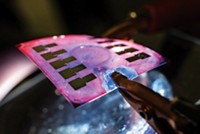Advertisement
Grab your lab coat. Let's get started
Welcome!
Welcome!
Create an account below to get 6 C&EN articles per month, receive newsletters and more - all free.
It seems this is your first time logging in online. Please enter the following information to continue.
As an ACS member you automatically get access to this site. All we need is few more details to create your reading experience.
Not you? Sign in with a different account.
Not you? Sign in with a different account.
ERROR 1
ERROR 1
ERROR 2
ERROR 2
ERROR 2
ERROR 2
ERROR 2
Password and Confirm password must match.
If you have an ACS member number, please enter it here so we can link this account to your membership. (optional)
ERROR 2
ACS values your privacy. By submitting your information, you are gaining access to C&EN and subscribing to our weekly newsletter. We use the information you provide to make your reading experience better, and we will never sell your data to third party members.
Materials
Hybrid Polymer Films For Solar Cells
July 16, 2007
| A version of this story appeared in
Volume 85, Issue 29
By combining the charge-transport properties of conjugated polyelectrolytes and the attractive physical properties of hyperbranched polymers, researchers have made new materials intended for solar cell applications. Kirk S. Schanze, John R. Reynolds, and colleagues at the University of Florida synthesized "hyperbranched conjugated polyelectrolytes," or HB-CPEs, from triphenylamine vinylene and thiophene groups via a reaction based on Heck polycondensation chemistry (J. Am. Chem. Soc. 2007, 129, 8958). The researchers chose these groups to expand the spectrum of visible light absorbed by solar cells. After characterizing the ionic polymers, they fabricated solar cells using HB-CPEs as monolayers and as self-assembled bilayers adsorbed onto titanium dioxide nanoparticles. The greater density of the bilayers resulted in photon-to-electron conversion efficiencies higher than that from monolayers. Performance of the new materials is lower than that of materials in conventional solar cells, the researchers note, but "prospects are high for rapid improvement."





Join the conversation
Contact the reporter
Submit a Letter to the Editor for publication
Engage with us on Twitter